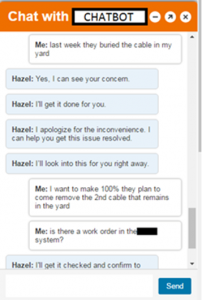Technology and artificial intelligence will continue to have a growing role in customer service. Many customers are wary of this, and have had negative experiences or views of AI. Some think chatbots will not be able to solve their problem or will not be helpful in finding answers.
Chatbots continue to grow in popularity as a tool for businesses to cost-effectively to reduce load on customer service operations. In many instances, they provide a perfect customer experience, especially where the information flow is simple Q and A: How do I accomplish X? You accomplish X by doing the following. However, when customer inquiries get more complex, the AI powering the chatbot can struggle because there’s often distinctions between what people say and what they mean.
For chatbots, in particular, this distinction has big implications for the customer experience. As a recent RetailWire article notes, more than three-quarters of consumers are not familiar with chatbots, yet companies often brand the chatbot as a human interaction, so when the inevitable complex query arises, there’s an inherent recipe for frustration since bots can’t process information the way a human does.
Consider this recent exchange between man and machine:
 (Image source: Arise)
(Image source: Arise)
Is this responsive? Helpful? Or just frustrating? There’s no doubt that AI and chatbots certainly have a disruptive future in customer care, but it’s critical to have human voice is sometimes needed. In fact, PSFK’s recent study, The Future of Retail 2017, says that 83 percent of consumers want a live person on the phone to handle customer service issues and, specifically relevant to chat, most users abandon chatbots after two messages.
While an automation-only strategy may seem more cost-efficient from the reduction in live agent costs resolving simple issues, having live agent service backing-up is critical. According to VentureBeat, the area bots alone can handle is only a “tiny slice” of an organization’s contact volume meaning that rest may not be able to have their issues resolved, a point of intense frustration to many consumers according to Arise’s Customer Frustration Series. In fact, three out of five Americans would switch to another company if it had better service and 86% will pay more for better customer support.
While 2017 is being dubbed by many the “year of the chatbot,” if your customer care organization is looking to choose between man and machine, it’s asking the wrong question. Companies who are successful in chatbot implementations will keep seamless live agent service backing-up chatbot experiences to solve more complex customer care issues. Lose the personal touch and you may lose the customer too.




My key takeaway is one of the concluding statements in your post: “… if your customer care organization is looking to choose between man and machine, it’s asking the wrong question.” Technology and cost-reduction are not panaceas. If they were, re-engineering would have been more successful instead of throwing many adherents into chaos.
For every element of experience, the name of the game is perceived customer value, on both a functional and emotional level. If it isn’t determined that the customer is getting requisite value and desired resolution from service chatbots, how and where they are used should be strategically re-thought.
At best, keyboards and voice transcription technology are flawed ways to transfer human thought and emotion into digital form. So I question the ability for Chatbots to provide a “perfect” customer experience. A good customer experience, or an acceptable customer experience? – sure. I think these are possible to measure, and possible to achieve, whereas a “perfect” experience is neither.
I’m troubled by the flow of the chat conversation shown in the article, and am wondering what disclosures are made to consumers when providers use automation tools for customer support. We’ve already become familiar with robotic voices during vendor phone interactions, and I suspect that as sophisticated as some systems are, it’s still rare for customers to be confused about whether they are speaking with a person, vs. interacting with software.
Chatbots are different, and it appears that the screen conceals the fact that there’s no human “behind the curtain.” Computers are not named “Hazel”, and “I can see your concern,” connotes understanding exists when it doesn’t. At the same time, it would be lame to return “input accepted,” and “processing . . .” after a customer’s inquiry. But I think an honesty threshold has been crossed when it’s opaque to a customer whether they are sustaining a dialog with a person. I think vendors need to disclose that information at the outset of the support session.
Chatbots, et al, do have a place, but mainly for informational purposes only. A customer on the receiving end of a perceived poor customer experience wants to speak first with a living breathing human.